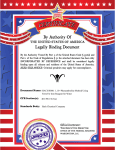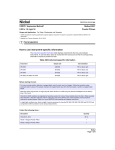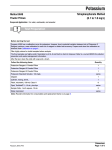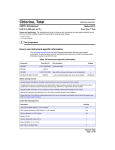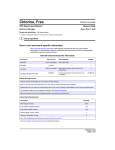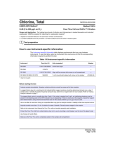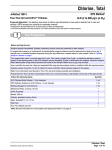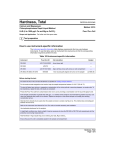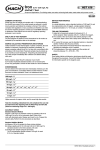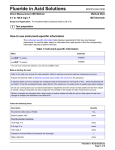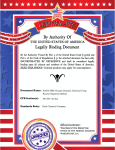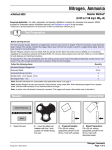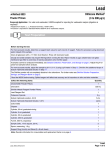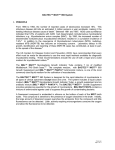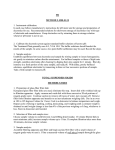Download Iron, Total - Advance Laboratorios
Transcript
ron Total FerroVer, 8008 Iron, Total DOC316.53.01314 USEPA1 FerroVer® Method2 Method 10249 0.1-3.0, 1.0-30.0 and 10.0-300.0 mg/L Powder Pillows Scope and Application: For oil and gas field waters; digestion is required for determining total iron 1 USEPA approved for reporting wastewater analysis, Federal Register, June 27, 1980; 45 (126:43459) 2 Adapted from Standard Methods for the Examination of Water and Wastewater. Test preparation How to use instrument-specific information Table 1 displays requirements that may vary between instruments. To use this table, select an instrument then read across to find the corresponding information required to perform this test. Table 1 Instrument-specific information Instrument Sample cell Cell orientation Adapter DR 5000 2495402 Fill line faces user A23618 DR 3900 2495402 Fill line faces user DR 3800, DR 2800, DR 2700 2495402 Fill line faces right Before starting the test: Digestion is required for determining total iron for EPA reporting purposes. Use the mild or vigorous digestion. Refer to the Water Analysis Guide for more information. For more accurate results, determine a reagent blank value for each new lot of reagent. Follow the procedure using deionized water in place of the sample. Subtract the reagent blank value from the final results or perform a reagent blank adjust. See the user manual for more information. Adjust pH of stored samples before analysis. Collect the following items: Description Quantity Powder Pillow Test: FerroVer® Iron Reagent Powder Pillow 1 Sample Cells (see Table 1) 1 See Consumables and replacement items for reorder information. Iron, Total Page 1 of 6 Iron, Total FerroVer method for powder pillows Stored Programs 265 Iron, FerroVer Start 1. Select the test. Insert an adapter if required (see Table 1). Refer to the user manual for orientation. 2. Prepared sample: Fill a clean sample cell with 10 mL of sample for 0.023.0 mg/l range. 3. If sample volume is less than 10 mL, add deionized water to the 10mL line. Swirl to mix. 4. Add 2 drops of EDTA Solution 1M to the sample. Swirl to mix. 7. Remove the cell and add the contents of one FerroVer Iron Reagent Powder Pillow to the sample cell. Swirl to mix. 8. Start the instrument timer. Use 1.0 mL of sample for the 0.2-30.0 mg/L range; enter Dilution Factor of 10. See Set the Dilution Factor. Use 0.1 mL of sample for the 2.0-300.0 range. Use Dilution Factor of 100. See Set the Dilution Factor. Note: Use a TenSette or glass pipet to measure 0.1 mL or 1.0 mL. Zero 5. Insert the sample into the cell holder. 6. Zero the instrument. The display will show: 0.0 mg/L Fe Accuracy is not affected by undissolved powder. Iron, Total Page 2 of 6 A three-minute reaction period begins. If iron is present, an orange color will form. Iron, Total FerroVer method for powder pillows (continued) 9. When the timer expires, insert the prepared sample into the cell holder. READ the results in mg/L Fe. Interferences The known interferences are shown in Table 2. Table 2 Interfering substances Interfering substance Interference level Barium, Ba2+ The dilution of samples to measure iron lowers most barium concentrations below barium interference levels. No effects are seen on analyzed solutions which contain less than 500 mg/L barium. No effects are seen when 1.0 of 0.1 mL of sample is used in Step 5. A turbidity may show at higher levels. Add 5 drops of EDTA Solution to the solution in Step 5 and repeat the test. Allow the sample to react for 5 minutes. Calcium, Ca2+ No effect at less than 10,000 mg/L as CaCO3. Chloride, Cl– No effect at less than 185,000 mg/L. Copper, Cu2+ No effect. Masking agent is contained in FerroVer Reagent. High Iron Levels Inhibit color development. Dilute sample and re-test to verify results. Magnesium No effect at 100,000 mg/L as calcium carbonate. Molybdate Molybdenum No effect at 50 mg/L as Mo. High Sulfide Levels, S2– 1. Treat in fume hood or well-ventilated area. Add 5 mL hydrochloric acid1, ACS to 100 mL sample in a 250 mL Erlenmeyer flask. Boil 20 minutes. 2. Cool. Adjust pH to 3–5 with Sodium Hydroxide1. Readjust volume to 100 mL with deionized water. Analyze using FerroVer method for powder pillows. 3. 1 Strontium, Sr2+ Strontium by itself does not interfere. Strontium in combination with Barium will cause a precipitate to form. The dilution of samples to measure iron lowers most strontium concentration below interference levels. No effects are seen on analyzed solutions when 1.0 or 0.1 mL of sample is used in step 4. A turbidity may start at higher levels. Add 5 drops of EDTA Solution to the solution in Step 5 and repeat the analysis again. Allow the sample to react for 5 minutes. Extreme Sample pH Adjust pH to 3–5. Highly Buffered Samples Adjust pH to 3–5. See Optional reagents and apparatus. Iron, Total Page 3 of 6 Iron, Total Sample collection, preservation and storage • Collect samples in acid-cleaned glass or plastic containers. No acid addition is necessary if analyzing the sample immediately. • To preserve samples, adjust the pH to 2 or less with concentrated nitric acid (about 2 mL per liter). Preserved samples may be stored up to six months at room temperature. • Before analysis, adjust the pH to between 3 and 5 with 5.0 N Sodium Hydroxide Standard Solution. • Correct the test result for volume additions. • If only dissolved iron is to be determined, filter the sample before acid addition. Set the dilution factor The instrument can include the dilution factor in the result and show the concentration of the original, undiluted sample. For example, if the sample is diluted by a factor of 10, the instrument multiplies the result by 10 and shows the calculated result in the instrument display. 1. Select Options>More>Dilution factor from the instrument menu. 2. Enter the dilution factor: • 1 mL sample diluted to 10 mL: dilution factor is 10. • 0.1 mL sample diluted to 10 mL: dilution factor is 100. 3. Push OK to confirm. Push OK again. 4. Push RETURN to go back to the measurement screen. Accuracy check Standard additions method (sample spike) Required for accuracy check: • Iron Voluette® Ampule Standard, 25 mg/L • Ampule breaker • TenSette Pipet and Pipet Tips 1. After reading test results, leave the sample cell (unspiked sample) in the instrument. 2. Select Options>More>Standard Additions from the instrument menu. 3. Accept the default values for standard concentration, sample volume and spike volumes. After the values are accepted, the unspiked sample reading will appear in the top row. See the user manual for more information. 4. Open the standard solution ampule. 5. Prepare a 0.1 mL sample spike by adding 0.1 mL of standard to 10 mL of unspiked sample. Start the instrument timer. After the timer expires, read the result. 6. Prepare a 0.2 mL sample spike by adding 0.1 mL of standard to the 0.1 mL sample spike. Start the instrument timer. After the timer expires, read the result. 7. Prepare a 0.3 mL sample spike by adding 0.1 mL of standard to the 0.2 mL sample spike. Start the instrument timer. After the timer expires, read the result. 8. Select GRAPH to view the results. Select IDEAL LINE (or best-fit) to compare the standard addition results to the theoretical 100% recovery. Iron, Total Page 4 of 6 Iron, Total Standard solution method Note: Refer to the instrument user manual for specific software navigation instructions. Required for accuracy check: • Iron Standard Solution, 100 mg/L • 100-mL volumetric flask • Class A volumetric pipet, 2 mL • Deionized water • Pipet filler 1. Prepare a 2.00-mg/L Fe standard solution as follows: a. Pipet 2.00 mL of Iron Standard Solution, 100 mg/L, into a 100 mL volumetric flask. b. Dilute to the mark with deionized water. Mix well. Prepare this solution daily. 2. Use the 2.00 mg/L Fe standard solution in place of the sample. Follow the FerroVer method for powder pillows test procedure. 3. To adjust the calibration curve using the reading obtained with the Standard Solution, select Options > More > Standard Adjust from the instrument menu. 4. Turn on the Standard Adjust feature and accept the displayed concentration. If an alternate concentration is used, enter the concentration and adjust the curve to that value. Mixedparameter standards are also available to simulate various matrices. Method performance Program Standard Precision 95% Confidence Limits of Distribution Sensitivity Concentration change per 0.010 Abs change 265 2.00 mg/L Fe 1.99–2.01 mg/L Fe 0.021 mg/L Fe Summary of method FerroVer Iron Reagent converts all soluble iron and most insoluble forms of iron in the sample to soluble ferrous iron. The ferrous iron reacts with the 1-10 phenanthroline indicator in the reagent to form an orange color in proportion to the iron concentration. Test results are measured at 510 nm. Consumables and replacement items Required reagents Description FerroVer® Iron Reagent Powder Pillows (for 10-mL sample) EDTA Solution 1M 2 drops Quantity/Test Unit Catalog number 1 100/pkg 2105769 2 drops 50 mL 2241926 Iron, Total Page 5 of 6 Iron, Total Recommended standards Description Unit Iron Standard Solution, 100 mg/L Catalog number 100 mL 1417542 16/pkg 1425310 4L 27256 each 1970001 Pipet Tips, for TenSette Pipet 1970001 50/pkg 2185696 Pipet Tips, for TenSette Pipet 1970001 Iron Standard Solution, 10 mL Voluette® Ampule, 25 mg/L as Fe Water, deionized Pipet, TenSette, 0.1–1.0 mL 1000/pkg 2185628 Flask, volumetric, Class A, 100 mL each 1457442 Pipet, volumetric, Class A, 2.00 mL each 1451536 Pipet Filler, safety bulb each 1465100 Unit Catalog number Hydrochloric Acid, concentrated 500 mL 13449 Nitric Acid, concentrated 500 mL 15249 Sodium Hydroxide Standard Solution, 5.0 N 100 mL 245032 Glass Membrane Filter, 47 mm 100/pkg 253000 Glass Membrane Filter Holder each 234000 RoVer Rust Remover 454 g 30001 Spoon, measuring, 0.1 g each 51100 Optional reagents and apparatus Description FOR TECHNICAL ASSISTANCE, PRICE INFORMATION AND ORDERING: In the U.S.A. – Call toll-free 800-227-4224 Outside the U.S.A. – Contact the HACH office or distributor serving you. On the Worldwide Web – www.hach.com; E-mail – [email protected] © Hach Company, 2011–2012. All rights reserved. Printed in U.S.A. HACH COMPANY WORLD HEADQUARTERS Telephone: (970) 669-3050 FAX: (970) 669-2932 04/2012, Edition 2






